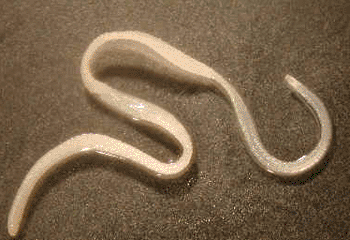Molecular Methods Identify Imported Tapeworm
By LabMedica International staff writers
Posted on 28 Jan 2013
Several locally acquired and imported clinical infections due to allochthonous fish tapeworm species have been seen in Europe in recent years. Posted on 28 Jan 2013
The incidence of human diphyllobothriasis has been increasing in several subalpine countries of Europe, and Diphyllobothrium latum is usually considered the causative agent of the disease.

Image: Diphyllobothrium dendriticum adult Cestode from the intestine of an Atlantic salmon (Photo courtesy of the Department of Inland Fisheries and Wildlife, State of Maine).
Scientists at the Dianalabs (Geneva, Switzerland) working with others, processed a fecal specimen by standard sedimentation technique to concentrate putatively present Diphyllobothrium eggs and subsequently assess these by light microscopy.
Genomic DNA was extracted from about 50 mg of proglottid tissue from the tapeworm with the DNeasy Blood and Tissue Kit (Qiagen; Hombrechtikon, Switzerland). Polymerase chain reaction (PCR) was performed using the Qiagen Taq PCR Master Mix Kit with primers targeting a region of the 5.8S ribosomal ribonucleic acid (5.8S rRNA), comprising internal transcribed spacers (ITS) 1 and 2, the 18S rRNA and the cytochrome c oxidase subunit 1 gene (cox1) sequences.
Microscopical analyses of the stained proglottids revealed the presence of only one set of reproductive organs per proglottid. The central uterine structure showed several rosette-shaped loops. Morphological criteria matched those described for Diphyllobothrium spp., while a species-specific identification was not possible based upon morphology. The position of the sample sequences of ITS1-5.8S rRNA and cox1 regions in the phylogenetic trees confirmed the cestode found in the fecal sample was D. dendriticum, also known as the salmon tapeworm. The phylogenetic tree built on the basis of 18S rRNA sequences was not useful for the discrimination of D. dendriticum from other species.
The authors concluded that due to the difficulties in discriminating the different Diphyllobothrium taxa by morphological characters, molecular analysis has proven to be fundamental to identify these helminths at the species level. They recommend the cheap and rapid molecular test based on multiplex PCR with partial cytochrome c oxidase subunit 1 (cox1) gene, without the need of sequencing that was recently developed for the differential identification of the most common species infecting humans. The study was published on January 17, 2013, in the journal Eurosurveillance.
Related Links:
Dianalabs
Qiagen













